Age Diversity: The Implications for the Management of Healthcare Professionals in Multicultural Teams
Added on 2020-06-03
44 Pages16878 Words45 Views
DISSERTATION
Age Diversity: The
Implications for the
Management of Healthcare
Professionals
in Multicultural Teams.
Age Diversity: The
Implications for the
Management of Healthcare
Professionals
in Multicultural Teams.
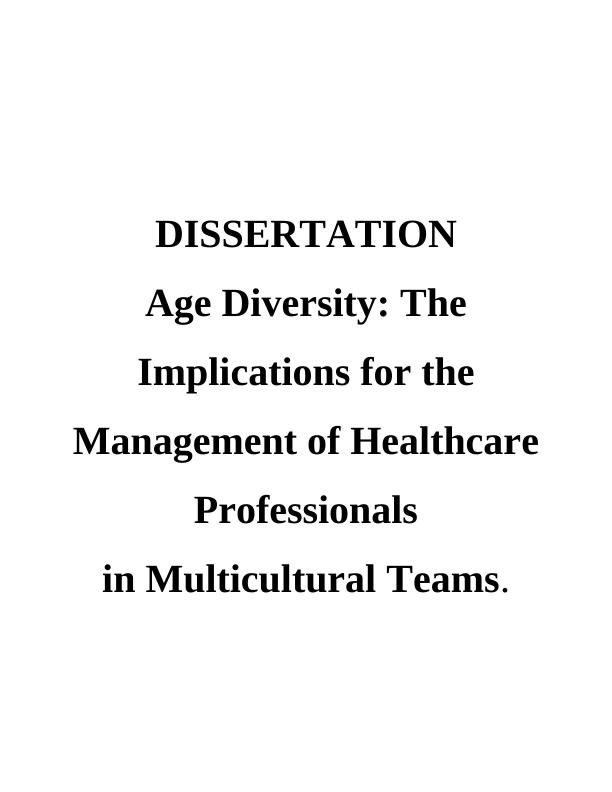
Table of Contents
INTRODUCTION...........................................................................................................................1
Chapter 1: Introduction....................................................................................................................1
1.1 Title ......................................................................................................................................1
1.2 Research Aim .......................................................................................................................1
1.3 Scope.....................................................................................................................................2
1.4 Literature Review..................................................................................................................2
1.5 Methodology.........................................................................................................................3
CHAPTER 2: LITERATURE REVIEW.........................................................................................3
2.1 Diversity................................................................................................................................3
2.1.1 Gender................................................................................................................................4
2.1.2 Culture................................................................................................................................4
2.1.3 Disability............................................................................................................................5
2.1.4 Sexual Orientation..............................................................................................................5
2.1.5 Age.....................................................................................................................................6
2.2 Diversity in Workplace.........................................................................................................6
2.3 Diversity Management..........................................................................................................8
2.4 Management..........................................................................................................................9
CHAPTER 3 .................................................................................................................................10
RESEARCH METHODOLOGY...................................................................................................10
3.1 Overview.............................................................................................................................10
3.2 Research design...................................................................................................................11
3.3 Research philosophy...........................................................................................................12
3.4 Research Approaches .........................................................................................................14
3.5 Research Strategy................................................................................................................15
3.6 Choice ................................................................................................................................17
3.7 Time Horizon......................................................................................................................17
3.8 Data collection and analysis................................................................................................18
3.9 Data Analysis .....................................................................................................................18
3.10 Sampling ..........................................................................................................................18
INTRODUCTION...........................................................................................................................1
Chapter 1: Introduction....................................................................................................................1
1.1 Title ......................................................................................................................................1
1.2 Research Aim .......................................................................................................................1
1.3 Scope.....................................................................................................................................2
1.4 Literature Review..................................................................................................................2
1.5 Methodology.........................................................................................................................3
CHAPTER 2: LITERATURE REVIEW.........................................................................................3
2.1 Diversity................................................................................................................................3
2.1.1 Gender................................................................................................................................4
2.1.2 Culture................................................................................................................................4
2.1.3 Disability............................................................................................................................5
2.1.4 Sexual Orientation..............................................................................................................5
2.1.5 Age.....................................................................................................................................6
2.2 Diversity in Workplace.........................................................................................................6
2.3 Diversity Management..........................................................................................................8
2.4 Management..........................................................................................................................9
CHAPTER 3 .................................................................................................................................10
RESEARCH METHODOLOGY...................................................................................................10
3.1 Overview.............................................................................................................................10
3.2 Research design...................................................................................................................11
3.3 Research philosophy...........................................................................................................12
3.4 Research Approaches .........................................................................................................14
3.5 Research Strategy................................................................................................................15
3.6 Choice ................................................................................................................................17
3.7 Time Horizon......................................................................................................................17
3.8 Data collection and analysis................................................................................................18
3.9 Data Analysis .....................................................................................................................18
3.10 Sampling ..........................................................................................................................18
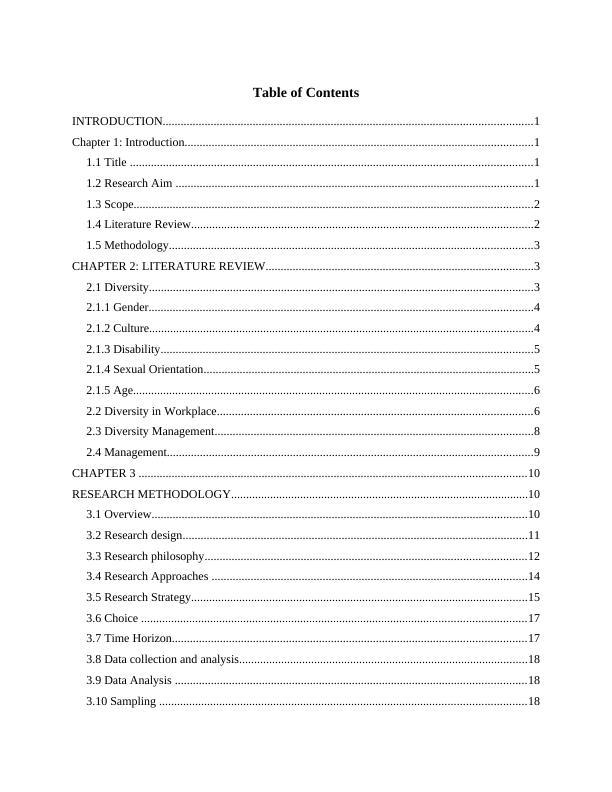
3.11 Ethical consideration.........................................................................................................20
CHAPTER 4: RESULTS AND DISCUSSION.............................................................................20
4.1 Introduction.........................................................................................................................20
4.2 Result and Discussion.........................................................................................................21
CHAPTER 5 RECOMMENDATION AND CONCLUSION......................................................33
Summary...................................................................................................................................33
Limitation..................................................................................................................................36
Recommendation.......................................................................................................................36
CHAPTER 4: RESULTS AND DISCUSSION.............................................................................20
4.1 Introduction.........................................................................................................................20
4.2 Result and Discussion.........................................................................................................21
CHAPTER 5 RECOMMENDATION AND CONCLUSION......................................................33
Summary...................................................................................................................................33
Limitation..................................................................................................................................36
Recommendation.......................................................................................................................36
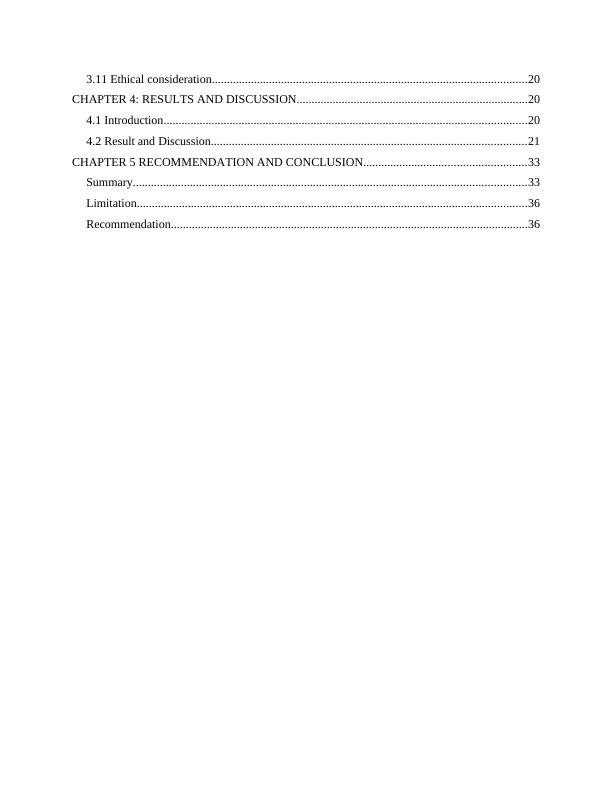
INTRODUCTION
Chapter 1: Introduction
1.1 Title
Age Diversity: The implications for the management of healthcare professionals in multicultural
teams.
1.2 Research Aim
In the recent years, globalization has increased around the world. One of the effect of the
globalization is the creation of cultural diversity in healthcare sector such as the National
Healthcare Service (NHS) and Private institutions in the United Kingdom. add reference!
Managers have the responsibility to create a cohesive team where the team members are working
efficiently and are well integrated together within an organization. The aim of the study is to
explore health professional managers’ perceptions of multicultural teams, and its effect on
managing those teams, with a specific focus on age. The study will explore whether age is a
variable that influences the management of multicultural teams.
Research Objectives
The main aim of this research is to explore health professional managers’ perceptions of
diversity and its effect on multicultural teams, exploa age as a variable. The study will look at
teams’ differences in diversity and the potential cultural issues that managers face on a daily
basis in work situations. The aim will be accomplished by achieving different research objectives
and research questions (RQ) outlined below.
I. To establish the relative importance of different aspects of diversity when managing
multicultural teams.
RQ: Which aspects of diversity are important in managing a multicultural team?
RQ: How do different aspects of diversity influence managers’ perceptions when managing
multicultural teams?
II. To assess potential conflicts managers face in managing multicultural teams.
RQ: What type of conflicts do managers face in managing multicultural teams?
RQ: How do managers prevent and resolve conflict in multicultural teams?
1
Chapter 1: Introduction
1.1 Title
Age Diversity: The implications for the management of healthcare professionals in multicultural
teams.
1.2 Research Aim
In the recent years, globalization has increased around the world. One of the effect of the
globalization is the creation of cultural diversity in healthcare sector such as the National
Healthcare Service (NHS) and Private institutions in the United Kingdom. add reference!
Managers have the responsibility to create a cohesive team where the team members are working
efficiently and are well integrated together within an organization. The aim of the study is to
explore health professional managers’ perceptions of multicultural teams, and its effect on
managing those teams, with a specific focus on age. The study will explore whether age is a
variable that influences the management of multicultural teams.
Research Objectives
The main aim of this research is to explore health professional managers’ perceptions of
diversity and its effect on multicultural teams, exploa age as a variable. The study will look at
teams’ differences in diversity and the potential cultural issues that managers face on a daily
basis in work situations. The aim will be accomplished by achieving different research objectives
and research questions (RQ) outlined below.
I. To establish the relative importance of different aspects of diversity when managing
multicultural teams.
RQ: Which aspects of diversity are important in managing a multicultural team?
RQ: How do different aspects of diversity influence managers’ perceptions when managing
multicultural teams?
II. To assess potential conflicts managers face in managing multicultural teams.
RQ: What type of conflicts do managers face in managing multicultural teams?
RQ: How do managers prevent and resolve conflict in multicultural teams?
1
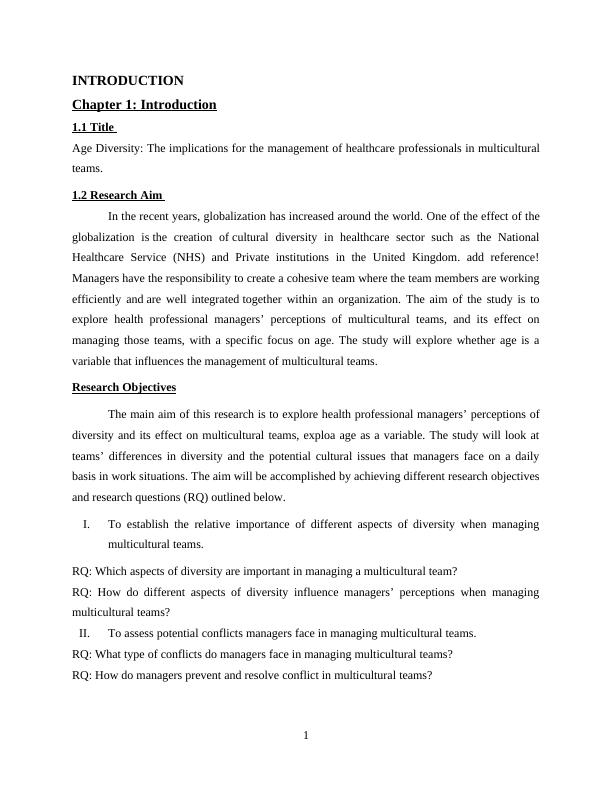
III. To investigate the extent of age stereotyping by managers and their perception of their
ability to manage a multicultural team.
RQ: How does age stereotyping influence managers’ perceptions of their ability to manage a
multicultural team?
IV. To investigate the effect of age on team members’ perceptions of their manager’s ability
to manage a multicultural team.
RQ: How does age stereotyping influence team members’ perceptions of their manager’s ability
to manage a multicultural team?
V. To investigate if training in diversity management improves the management of
multicultural teams.
RQ: How can training in diversity management improve the management of a multicultural
team?
1.3 Scope
The scope of this study sets out to research managers’ acceptance of diversity when the
manager is in a minority age giving compared to the rest of the team. The research focuses on the
manager’s acceptance, divided in three steps. First the study will focus on managers in three
areas inside the healthcare organization, Imaging, Pharmacy, and Nursing. Finally the findings
will be compared with company’s policies and evaluation if new policy review and
implementation will determine and required. The Will be set within the private healthcare sector
in the United Kingdom, and will focus on a simple case study organization.
1.4 Literature Review
The NHS and its diversity integration has been a subject of many studies in terms of
discrimination against Black, Minority and Ethnic (BME) and other groups including women,
people with disabilities, and religious groups (West, Dawson, and Kaur, 2015). A few studies
focused on evaluating strategies for implementing diversity at a senior level in NHS, and staff
inequality against the black and minority populations (Esmail, Kalra and Abel, 2005). The NHS
represents the biggest workforce in the UK. It composes a numbers of diverse groups, as where
in the case of NHS in London, the institution is as diverse as the city’s population reference here.
For this reason, it is relative easy to find cases of reported discrimination against other staff
members in the NHS (Kline, 2014). Some studies have paid attention to managers and their
2
ability to manage a multicultural team.
RQ: How does age stereotyping influence managers’ perceptions of their ability to manage a
multicultural team?
IV. To investigate the effect of age on team members’ perceptions of their manager’s ability
to manage a multicultural team.
RQ: How does age stereotyping influence team members’ perceptions of their manager’s ability
to manage a multicultural team?
V. To investigate if training in diversity management improves the management of
multicultural teams.
RQ: How can training in diversity management improve the management of a multicultural
team?
1.3 Scope
The scope of this study sets out to research managers’ acceptance of diversity when the
manager is in a minority age giving compared to the rest of the team. The research focuses on the
manager’s acceptance, divided in three steps. First the study will focus on managers in three
areas inside the healthcare organization, Imaging, Pharmacy, and Nursing. Finally the findings
will be compared with company’s policies and evaluation if new policy review and
implementation will determine and required. The Will be set within the private healthcare sector
in the United Kingdom, and will focus on a simple case study organization.
1.4 Literature Review
The NHS and its diversity integration has been a subject of many studies in terms of
discrimination against Black, Minority and Ethnic (BME) and other groups including women,
people with disabilities, and religious groups (West, Dawson, and Kaur, 2015). A few studies
focused on evaluating strategies for implementing diversity at a senior level in NHS, and staff
inequality against the black and minority populations (Esmail, Kalra and Abel, 2005). The NHS
represents the biggest workforce in the UK. It composes a numbers of diverse groups, as where
in the case of NHS in London, the institution is as diverse as the city’s population reference here.
For this reason, it is relative easy to find cases of reported discrimination against other staff
members in the NHS (Kline, 2014). Some studies have paid attention to managers and their
2
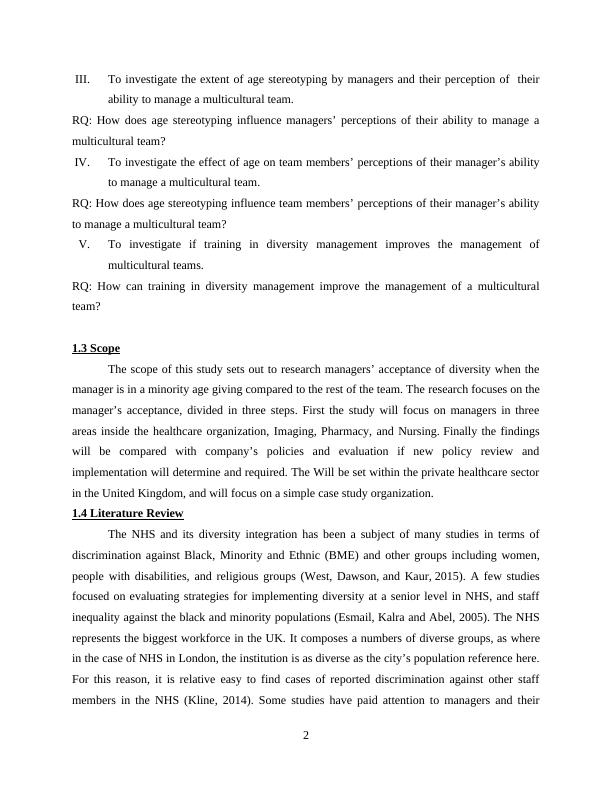
mediating role in performance, relationship with and among the followers, team work,
outstanding performance, and the team’s ability to integrate different ethnic backgrounds. The
literature shows discrimination and inequality of staff in lower positions, but little research, has
focused on age discrimination reference here.
1.5 Methodology
The most important decision that a researcher has to make is the selection of the best
research methodology, because the report and the results are strictly connected to the choice of
methodology. There are two approaches that can be used in research methods; qualitative or
quantitative. For this single case study, qualitative approach is the best approach. The data
collection will be come out via interviews of between eight to ten senior staff who belong to the
Imaging, Pharmacy, and Nursing departments. The questionnaires will be first approved by the
research supervisor. The study is not intended to cause harm or offend any of the subjects
involved in the research. Also, the collected data will be kept anonymous and treated with high
confidentiality. The data will be processed with Microsoft Word software.
CHAPTER 2: LITERATURE REVIEW
This chapter will focus on an overview of current literature on multiple aspects of
diversity such as, gender, culture, age, disability and sexual orientation. Then, the literature will
further look into diversity specifically in workplace, diversity management, and management
more generally
2.1 Diversity
The term diversity refers to a range of people that are very different to each other.
O’Reilly et al (1998) refer to diversity as a group formed of individuals who have different
characteristics and social identities (O’Reilly et al, 1998). Hubbard and other researchers divide
diversity into primary and secondary groups. In the primary group race, age, physical abilities,
and gender are included. The secondary group includes socioeconomic status, education, religion
and geographical affiliation, first language, work experience, organizational role and level, and
communication style, which are less visible. The primary group can be connected to the essential
self-image views of the world. The second group is connected to the dimensions that effect our
self-definition (Hubbard et al, 2004).
3
outstanding performance, and the team’s ability to integrate different ethnic backgrounds. The
literature shows discrimination and inequality of staff in lower positions, but little research, has
focused on age discrimination reference here.
1.5 Methodology
The most important decision that a researcher has to make is the selection of the best
research methodology, because the report and the results are strictly connected to the choice of
methodology. There are two approaches that can be used in research methods; qualitative or
quantitative. For this single case study, qualitative approach is the best approach. The data
collection will be come out via interviews of between eight to ten senior staff who belong to the
Imaging, Pharmacy, and Nursing departments. The questionnaires will be first approved by the
research supervisor. The study is not intended to cause harm or offend any of the subjects
involved in the research. Also, the collected data will be kept anonymous and treated with high
confidentiality. The data will be processed with Microsoft Word software.
CHAPTER 2: LITERATURE REVIEW
This chapter will focus on an overview of current literature on multiple aspects of
diversity such as, gender, culture, age, disability and sexual orientation. Then, the literature will
further look into diversity specifically in workplace, diversity management, and management
more generally
2.1 Diversity
The term diversity refers to a range of people that are very different to each other.
O’Reilly et al (1998) refer to diversity as a group formed of individuals who have different
characteristics and social identities (O’Reilly et al, 1998). Hubbard and other researchers divide
diversity into primary and secondary groups. In the primary group race, age, physical abilities,
and gender are included. The secondary group includes socioeconomic status, education, religion
and geographical affiliation, first language, work experience, organizational role and level, and
communication style, which are less visible. The primary group can be connected to the essential
self-image views of the world. The second group is connected to the dimensions that effect our
self-definition (Hubbard et al, 2004).
3

2.1.1 Gender
Gender diversity is the centre of diversity in literature, divided into different levels. One
area of gender diversity in the literature is related to pay
discrimination. Brynin and Güveli’s 2012 study shows that there is no association between
gender and lower pay. On the other hand, Woodhams, Lupton and Cowling (2013) argue that
there are associations between gender and lower pay, which require additional studies focused on
pay measures. The second area of gender diversity considers discrimination in corporate boards.
According to Dobbin and Jung (2011) the effect of corporate performance per gender presence in
corporate leadership was found to be inconclusive, as there are insufficient studies to support
correlation between performance and gender differences in leadership. Mavin, Grandy, and
Williams (2014), view the effect of cultural diversity, and the number of women on corporate
director’s role in a positive way. Another aspect of gender diversity interaction among team
members inside the organization. . Gender diversity has positive consequences for company,
while individual and isolation is not much helpful (Dwyer, Richard, and Chadwick, 2003)
2.1.2 Culture
Cultural diversity relates to racial and ethnic diversity Cultural diversity can have
influence on the individual and group outcomes. There are some debates about positive or
negative effects of cultural diversity in workplace. Cox, Lobel and McLeod (1991) states that
cultural diversity can increase learning and problem solving. The learning process has a
positive consequence on individual, group and organization of outcomes; diverse work teams
make better decisions than homogeneous teams. But Dahilin, Weingart and Hinds (2005)
propose a negative aspect of cultural diversity in the workplace, such as social categorization
associated with national diversity. Negative stereotypes can affect group functioning. This is a
problem for managers or leaders forced to use different types of communication that can
facilitate the integration of the entire team. Mitchell, Parker and Giles (2011) identified diversity
as a potential source of conflict and has, as a consequence, poor performance. Despite some
negative opinions about cultural diversity in a work setting, the majority of the studies see
diversity as having positive outcomes. Gelfand, Erez and Aycan (2007) found the effects of
cultural differences on the performance of group and individuals inside an organization to be
inconclusive. All the findings are inquiry of critical role that manager or leader has in the team
performance.
4
Gender diversity is the centre of diversity in literature, divided into different levels. One
area of gender diversity in the literature is related to pay
discrimination. Brynin and Güveli’s 2012 study shows that there is no association between
gender and lower pay. On the other hand, Woodhams, Lupton and Cowling (2013) argue that
there are associations between gender and lower pay, which require additional studies focused on
pay measures. The second area of gender diversity considers discrimination in corporate boards.
According to Dobbin and Jung (2011) the effect of corporate performance per gender presence in
corporate leadership was found to be inconclusive, as there are insufficient studies to support
correlation between performance and gender differences in leadership. Mavin, Grandy, and
Williams (2014), view the effect of cultural diversity, and the number of women on corporate
director’s role in a positive way. Another aspect of gender diversity interaction among team
members inside the organization. . Gender diversity has positive consequences for company,
while individual and isolation is not much helpful (Dwyer, Richard, and Chadwick, 2003)
2.1.2 Culture
Cultural diversity relates to racial and ethnic diversity Cultural diversity can have
influence on the individual and group outcomes. There are some debates about positive or
negative effects of cultural diversity in workplace. Cox, Lobel and McLeod (1991) states that
cultural diversity can increase learning and problem solving. The learning process has a
positive consequence on individual, group and organization of outcomes; diverse work teams
make better decisions than homogeneous teams. But Dahilin, Weingart and Hinds (2005)
propose a negative aspect of cultural diversity in the workplace, such as social categorization
associated with national diversity. Negative stereotypes can affect group functioning. This is a
problem for managers or leaders forced to use different types of communication that can
facilitate the integration of the entire team. Mitchell, Parker and Giles (2011) identified diversity
as a potential source of conflict and has, as a consequence, poor performance. Despite some
negative opinions about cultural diversity in a work setting, the majority of the studies see
diversity as having positive outcomes. Gelfand, Erez and Aycan (2007) found the effects of
cultural differences on the performance of group and individuals inside an organization to be
inconclusive. All the findings are inquiry of critical role that manager or leader has in the team
performance.
4
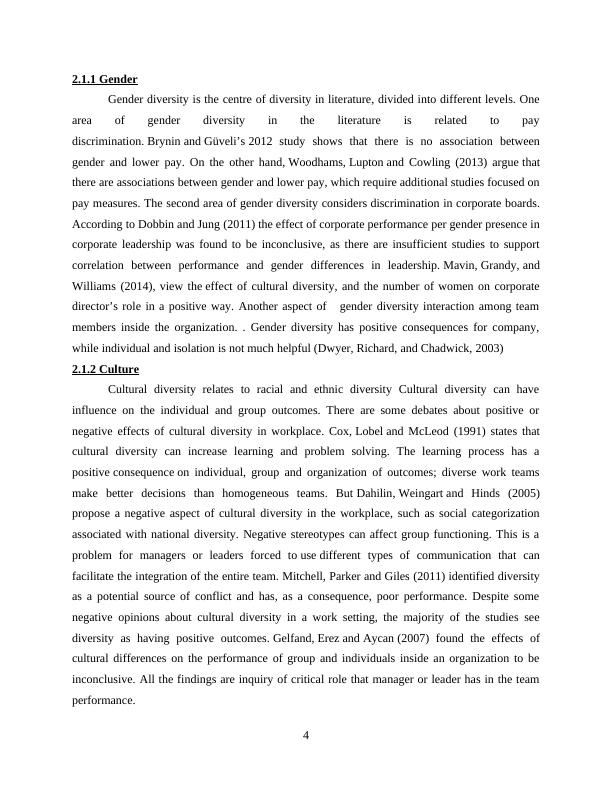
2.1.3 Disability
According to Bell (2011), disability is the main area of diversity. Schur et al., (2009)
support that even consider different type of disability, in the literature disability is a negative
factor. Which include prejudice, discrimination and stereotype. The positive aspect is that
managers recognise their role is to attract and integrate different workforce characteristics inside
the workplace (Ball, Monaco, Schmeling, Shartz and Blank, 2005). The organization focus is to
establish an environment where employees with disabilities are well-integrated. To create the
condition where the talent of employee with disability can be make best use of. Baumgärtner et
al. (2014) focused on the need to have adjustments in the workplace and flexible schedules to
meet the needs of employees with disabilities. According to Kulkarni and Lengnick-Hall (2011)
the flexibility inside an organization plays a strong role in the participation of people with
disabilities within a team. In this context we need to pay attention to functional role of managers.
They have the abilities to support or depress with attitudes and actions the integration of people
with disabilities. In the same way, managers play an important role when considering the
different needs of the disabled employees within the rest of the team. The manager can generate
policies that can increase the gratification of the employees with disability. reference
2.1.4 Sexual Orientation
Sexual orientation diversity can create many stereotypes inside the organization. For this
reason, according to Ozturk and Rumens (2014), employees frequently hide gay, lesbian and
bisexual orientation. In the literature sexual orientation diversity individuals inside a company
can be victims of practice of heterosexism and discrimination. High stress levels is one of the
consequences of heterosexism, followed by less opportunity for career progression and lower
pay for gay men by Berg and Lien (2002). The freedom to decide to expose their sexual
orientation could have as the effect of directing lesbian, gay, bisexual and transgender (LBGT) in
a lower pay sector. To aim of higher paying job, for the sexual diversity employees must keep
their sexuality hidden. The Equality Act and anti-discrimination legislation, have been developed
to help and support the LGBT employees. On the other hand Wang and Schwarz (2010) support
that in many countries these legislations are not developed and the sexual diversity is still
considered as negative aspect for some organizations Reference here!.
5
According to Bell (2011), disability is the main area of diversity. Schur et al., (2009)
support that even consider different type of disability, in the literature disability is a negative
factor. Which include prejudice, discrimination and stereotype. The positive aspect is that
managers recognise their role is to attract and integrate different workforce characteristics inside
the workplace (Ball, Monaco, Schmeling, Shartz and Blank, 2005). The organization focus is to
establish an environment where employees with disabilities are well-integrated. To create the
condition where the talent of employee with disability can be make best use of. Baumgärtner et
al. (2014) focused on the need to have adjustments in the workplace and flexible schedules to
meet the needs of employees with disabilities. According to Kulkarni and Lengnick-Hall (2011)
the flexibility inside an organization plays a strong role in the participation of people with
disabilities within a team. In this context we need to pay attention to functional role of managers.
They have the abilities to support or depress with attitudes and actions the integration of people
with disabilities. In the same way, managers play an important role when considering the
different needs of the disabled employees within the rest of the team. The manager can generate
policies that can increase the gratification of the employees with disability. reference
2.1.4 Sexual Orientation
Sexual orientation diversity can create many stereotypes inside the organization. For this
reason, according to Ozturk and Rumens (2014), employees frequently hide gay, lesbian and
bisexual orientation. In the literature sexual orientation diversity individuals inside a company
can be victims of practice of heterosexism and discrimination. High stress levels is one of the
consequences of heterosexism, followed by less opportunity for career progression and lower
pay for gay men by Berg and Lien (2002). The freedom to decide to expose their sexual
orientation could have as the effect of directing lesbian, gay, bisexual and transgender (LBGT) in
a lower pay sector. To aim of higher paying job, for the sexual diversity employees must keep
their sexuality hidden. The Equality Act and anti-discrimination legislation, have been developed
to help and support the LGBT employees. On the other hand Wang and Schwarz (2010) support
that in many countries these legislations are not developed and the sexual diversity is still
considered as negative aspect for some organizations Reference here!.
5

End of preview
Want to access all the pages? Upload your documents or become a member.
Related Documents
Investigation of Groupthink in Project Managementlg...
|43
|11202
|76
Dissertation on Socio-cultural Diversity on Leadershiplg...
|58
|14803
|185
Globalization and Team Culture: A Study of Emirates Airlinelg...
|97
|23443
|418
Dissertation on Impact of Socio-cultural Diversity on Leadershiplg...
|56
|14775
|170
Essay on Diversity in Leadershiplg...
|9
|2368
|48
Diversity in Healthcare Workforce of Australialg...
|9
|2916
|95
